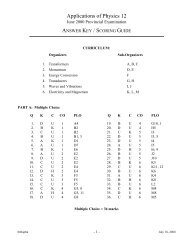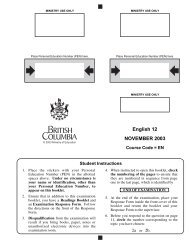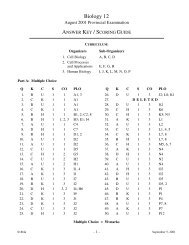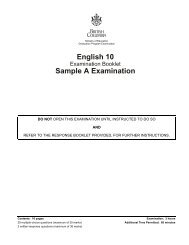ENGLISH 12 - QuestionBank.CA
ENGLISH 12 - QuestionBank.CA
ENGLISH 12 - QuestionBank.CA
You also want an ePaper? Increase the reach of your titles
YUMPU automatically turns print PDFs into web optimized ePapers that Google loves.
27 One thrives in a high-salt environment that would literally suck life out of other life forms. Thesemicrobes occur around the world in salt ponds and other high-salt environments, including theDead Sea. They’ve even been found inside salt crystals in British salt mines.28 The other microbe they are dissecting is a heat-lover known as sulfolobus. It is common in hotsprings, geysers and deep-sea vents, where temperatures can hit 350 degrees Celsius.29 The UBC work is part of an international research effort to define the chemical tricks themicrobes use to survive in extreme environments.30 Powerful chemical bridges are built into the microbes’ proteins to hold the molecules together.This allows the proteins, which include enzymes and other chemical workhorses, to maintain theirshape and function in heat and salt that would destroy the flimsier proteins common to othermicrobes.31 There are plenty of practical applications for the tough molecules. Some enzymes from heatlovingarchaea have already been put to work in genetic engineering machines, where they copyand splice together genetic molecules. And they may prove valuable in industrial processes thatrequire high heat.32 There is speculation that organisms in the archaea family are the closest remaining descendants ofEarth’s earliest life forms. That is because so many of the microbes thrive in extremeenvironments that might have been common when primordial stew swirled around the planet.33 Dennis says recent speculation that microbes lived on Mars once again raises the possibility thatlife on Earth was seeded from space. It’s clear from biochemicals found in everything fromarchaea to humans that all life on Earth shares common ancestors: proteins, genes and nucleicacid on Earth all use the same building blocks. And life on other planets could use the samechemicals. But without an extraterrestrial sample, the question will remain unanswered.34 While the scientists have used every possible tool at their disposal to prove the meteorite wasonce inhabited by Martian microbes, Vali says the evidence remains suggestive but inconclusive.“We don’t have the proof yet.”- 3 -OVER
















